Andrea Cavallo
Sparse Covariance Neural Networks
Oct 02, 2024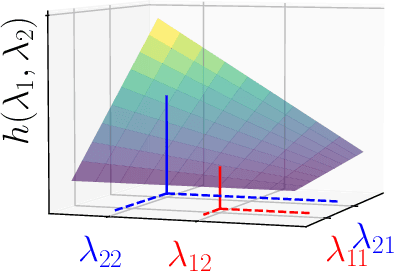



Abstract:Covariance Neural Networks (VNNs) perform graph convolutions on the covariance matrix of tabular data and achieve success in a variety of applications. However, the empirical covariance matrix on which the VNNs operate may contain many spurious correlations, making VNNs' performance inconsistent due to these noisy estimates and decreasing their computational efficiency. To tackle this issue, we put forth Sparse coVariance Neural Networks (S-VNNs), a framework that applies sparsification techniques on the sample covariance matrix before convolution. When the true covariance matrix is sparse, we propose hard and soft thresholding to improve covariance estimation and reduce computational cost. Instead, when the true covariance is dense, we propose stochastic sparsification where data correlations are dropped in probability according to principled strategies. We show that S-VNNs are more stable than nominal VNNs as well as sparse principal component analysis. By analyzing the impact of sparsification on their behavior, we provide novel connections between S-VNN stability and data distribution. We support our theoretical findings with experimental results on various application scenarios, ranging from brain data to human action recognition, and show an improved task performance, stability, and computational efficiency of S-VNNs compared with nominal VNNs.
Spatiotemporal Covariance Neural Networks
Sep 16, 2024Abstract:Modeling spatiotemporal interactions in multivariate time series is key to their effective processing, but challenging because of their irregular and often unknown structure. Statistical properties of the data provide useful biases to model interdependencies and are leveraged by correlation and covariance-based networks as well as by processing pipelines relying on principal component analysis (PCA). However, PCA and its temporal extensions suffer instabilities in the covariance eigenvectors when the corresponding eigenvalues are close to each other, making their application to dynamic and streaming data settings challenging. To address these issues, we exploit the analogy between PCA and graph convolutional filters to introduce the SpatioTemporal coVariance Neural Network (STVNN), a relational learning model that operates on the sample covariance matrix of the time series and leverages joint spatiotemporal convolutions to model the data. To account for the streaming and non-stationary setting, we consider an online update of the parameters and sample covariance matrix. We prove the STVNN is stable to the uncertainties introduced by these online estimations, thus improving over temporal PCA-based methods. Experimental results corroborate our theoretical findings and show that STVNN is competitive for multivariate time series processing, it adapts to changes in the data distribution, and it is orders of magnitude more stable than online temporal PCA.
* Joint European Conference on Machine Learning and Knowledge Discovery in Databases (ECML PKDD) 2024
Fair CoVariance Neural Networks
Sep 13, 2024Abstract:Covariance-based data processing is widespread across signal processing and machine learning applications due to its ability to model data interconnectivities and dependencies. However, harmful biases in the data may become encoded in the sample covariance matrix and cause data-driven methods to treat different subpopulations unfairly. Existing works such as fair principal component analysis (PCA) mitigate these effects, but remain unstable in low sample regimes, which in turn may jeopardize the fairness goal. To address both biases and instability, we propose Fair coVariance Neural Networks (FVNNs), which perform graph convolutions on the covariance matrix for both fair and accurate predictions. Our FVNNs provide a flexible model compatible with several existing bias mitigation techniques. In particular, FVNNs allow for mitigating the bias in two ways: first, they operate on fair covariance estimates that remove biases from their principal components; second, they are trained in an end-to-end fashion via a fairness regularizer in the loss function so that the model parameters are tailored to solve the task directly in a fair manner. We prove that FVNNs are intrinsically fairer than analogous PCA approaches thanks to their stability in low sample regimes. We validate the robustness and fairness of our model on synthetic and real-world data, showcasing the flexibility of FVNNs along with the tradeoff between fair and accurate performance.
Higher-Order Topological Directionality and Directed Simplicial Neural Networks
Sep 12, 2024
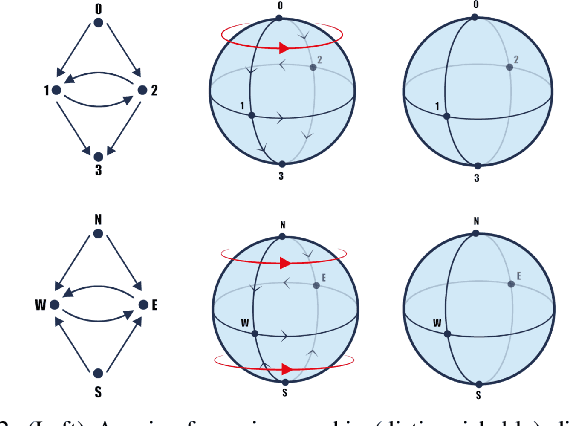


Abstract:Topological Deep Learning (TDL) has emerged as a paradigm to process and learn from signals defined on higher-order combinatorial topological spaces, such as simplicial or cell complexes. Although many complex systems have an asymmetric relational structure, most TDL models forcibly symmetrize these relationships. In this paper, we first introduce a novel notion of higher-order directionality and we then design Directed Simplicial Neural Networks (Dir-SNNs) based on it. Dir-SNNs are message-passing networks operating on directed simplicial complexes able to leverage directed and possibly asymmetric interactions among the simplices. To our knowledge, this is the first TDL model using a notion of higher-order directionality. We theoretically and empirically prove that Dir-SNNs are more expressive than their directed graph counterpart in distinguishing isomorphic directed graphs. Experiments on a synthetic source localization task demonstrate that Dir-SNNs outperform undirected SNNs when the underlying complex is directed, and perform comparably when the underlying complex is undirected.
ICML Topological Deep Learning Challenge 2024: Beyond the Graph Domain
Sep 08, 2024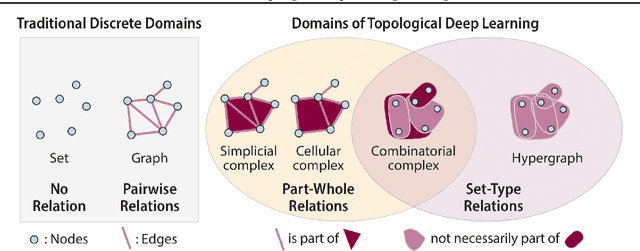
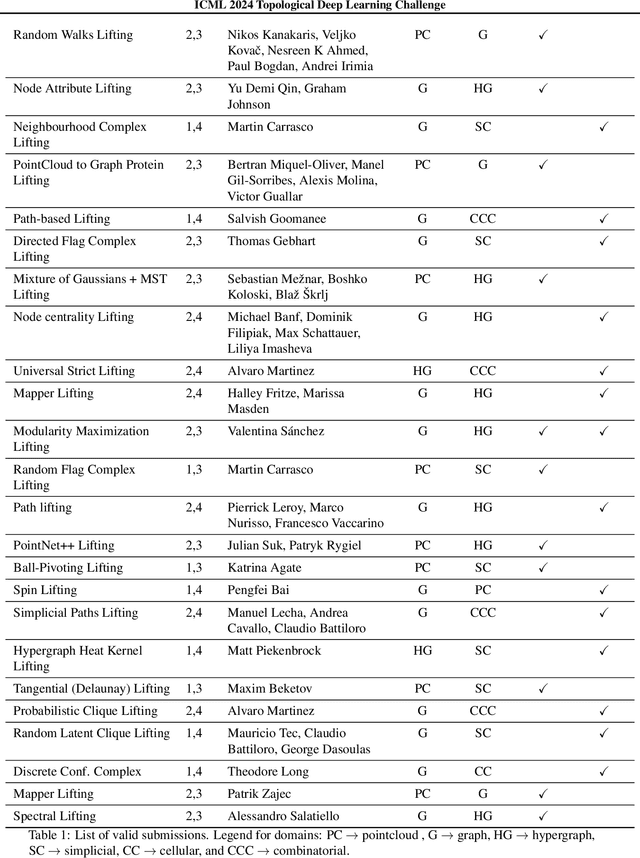
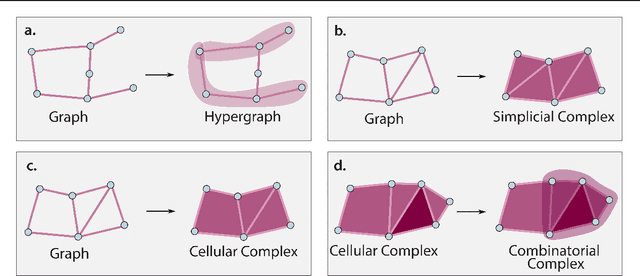
Abstract:This paper describes the 2nd edition of the ICML Topological Deep Learning Challenge that was hosted within the ICML 2024 ELLIS Workshop on Geometry-grounded Representation Learning and Generative Modeling (GRaM). The challenge focused on the problem of representing data in different discrete topological domains in order to bridge the gap between Topological Deep Learning (TDL) and other types of structured datasets (e.g. point clouds, graphs). Specifically, participants were asked to design and implement topological liftings, i.e. mappings between different data structures and topological domains --like hypergraphs, or simplicial/cell/combinatorial complexes. The challenge received 52 submissions satisfying all the requirements. This paper introduces the main scope of the challenge, and summarizes the main results and findings.
GCNH: A Simple Method For Representation Learning On Heterophilous Graphs
Apr 21, 2023Abstract:Graph Neural Networks (GNNs) are well-suited for learning on homophilous graphs, i.e., graphs in which edges tend to connect nodes of the same type. Yet, achievement of consistent GNN performance on heterophilous graphs remains an open research problem. Recent works have proposed extensions to standard GNN architectures to improve performance on heterophilous graphs, trading off model simplicity for prediction accuracy. However, these models fail to capture basic graph properties, such as neighborhood label distribution, which are fundamental for learning. In this work, we propose GCN for Heterophily (GCNH), a simple yet effective GNN architecture applicable to both heterophilous and homophilous scenarios. GCNH learns and combines separate representations for a node and its neighbors, using one learned importance coefficient per layer to balance the contributions of center nodes and neighborhoods. We conduct extensive experiments on eight real-world graphs and a set of synthetic graphs with varying degrees of heterophily to demonstrate how the design choices for GCNH lead to a sizable improvement over a vanilla GCN. Moreover, GCNH outperforms state-of-the-art models of much higher complexity on four out of eight benchmarks, while producing comparable results on the remaining datasets. Finally, we discuss and analyze the lower complexity of GCNH, which results in fewer trainable parameters and faster training times than other methods, and show how GCNH mitigates the oversmoothing problem.
2-hop Neighbor Class Similarity : A graph structural metric indicative of graph neural network performance
Dec 26, 2022



Abstract:Graph Neural Networks (GNNs) achieve state-of-the-art performance on graph-structured data across numerous domains. Their underlying ability to represent nodes as summaries of their vicinities has proven effective for homophilous graphs in particular, in which same-type nodes tend to connect. On heterophilous graphs, in which different-type nodes are likely connected, GNNs perform less consistently, as neighborhood information might be less representative or even misleading. On the other hand, GNN performance is not inferior on all heterophilous graphs, and there is a lack of understanding of what other graph properties affect GNN performance. In this work, we highlight the limitations of the widely used homophily ratio and the recent Cross-Class Neighborhood Similarity (CCNS) metric in estimating GNN performance. To overcome these limitations, we introduce 2-hop Neighbor Class Similarity (2NCS), a new quantitative graph structural property that correlates with GNN performance more strongly and consistently than alternative metrics. 2NCS considers two-hop neighborhoods as a theoretically derived consequence of the two-step label propagation process governing GCN's training-inference process. Experiments on one synthetic and eight real-world graph datasets confirm consistent improvements over existing metrics in estimating the accuracy of GCN- and GAT-based architectures on the node classification task.
Predicting Human Intentions from Motion Only: A 2D+3D Fusion Approach
Sep 06, 2017
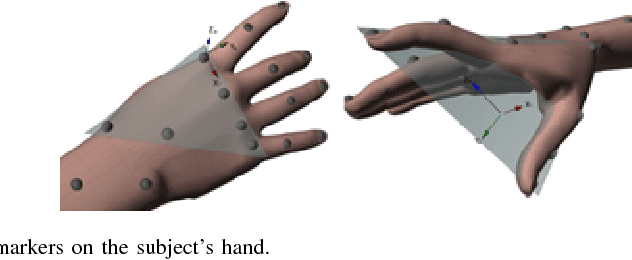


Abstract:In this paper, we address the new problem of the prediction of human intents. There is neuro-psychological evidence that actions performed by humans are anticipated by peculiar motor acts which are discriminant of the type of action going to be performed afterwards. In other words, an actual intent can be forecast by looking at the kinematics of the immediately preceding movement. To prove it in a computational and quantitative manner, we devise a new experimental setup where, without using contextual information, we predict human intents all originating from the same motor act. We posit the problem as a classification task and we introduce a new multi-modal dataset consisting of a set of motion capture marker 3D data and 2D video sequences, where, by only analysing very similar movements in both training and test phases, we are able to predict the underlying intent, i.e., the future, never observed action. We also present an extensive experimental evaluation as a baseline, customizing state-of-the-art techniques for either 3D and 2D data analysis. Realizing that video processing methods lead to inferior performance but show complementary information with respect to 3D data sequences, we developed a 2D+3D fusion analysis where we achieve better classification accuracies, attesting the superiority of the multimodal approach for the context-free prediction of human intents.
What Will I Do Next? The Intention from Motion Experiment
Aug 03, 2017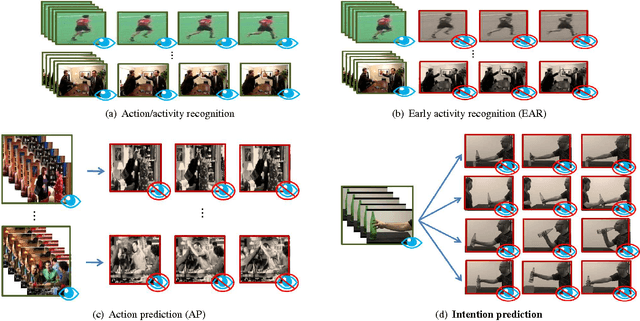
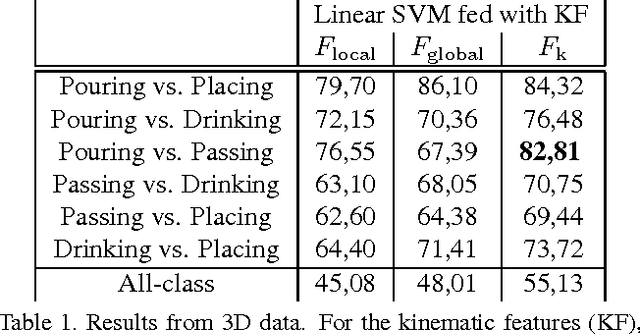
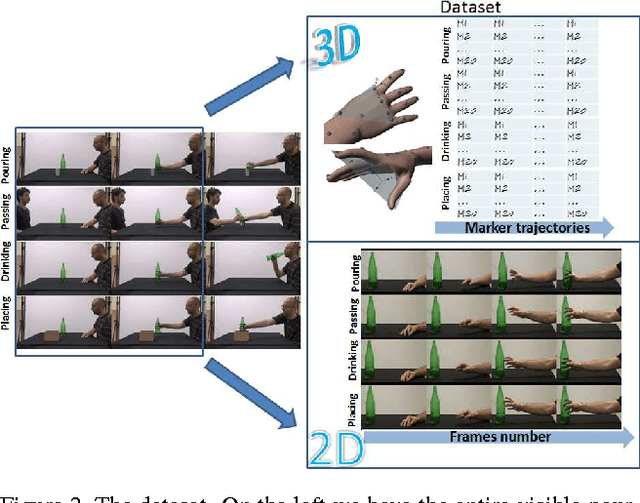

Abstract:In computer vision, video-based approaches have been widely explored for the early classification and the prediction of actions or activities. However, it remains unclear whether this modality (as compared to 3D kinematics) can still be reliable for the prediction of human intentions, defined as the overarching goal embedded in an action sequence. Since the same action can be performed with different intentions, this problem is more challenging but yet affordable as proved by quantitative cognitive studies which exploit the 3D kinematics acquired through motion capture systems. In this paper, we bridge cognitive and computer vision studies, by demonstrating the effectiveness of video-based approaches for the prediction of human intentions. Precisely, we propose Intention from Motion, a new paradigm where, without using any contextual information, we consider instantaneous grasping motor acts involving a bottle in order to forecast why the bottle itself has been reached (to pass it or to place in a box, or to pour or to drink the liquid inside). We process only the grasping onsets casting intention prediction as a classification framework. Leveraging on our multimodal acquisition (3D motion capture data and 2D optical videos), we compare the most commonly used 3D descriptors from cognitive studies with state-of-the-art video-based techniques. Since the two analyses achieve an equivalent performance, we demonstrate that computer vision tools are effective in capturing the kinematics and facing the cognitive problem of human intention prediction.
 Add to Chrome
Add to Chrome Add to Firefox
Add to Firefox Add to Edge
Add to Edge